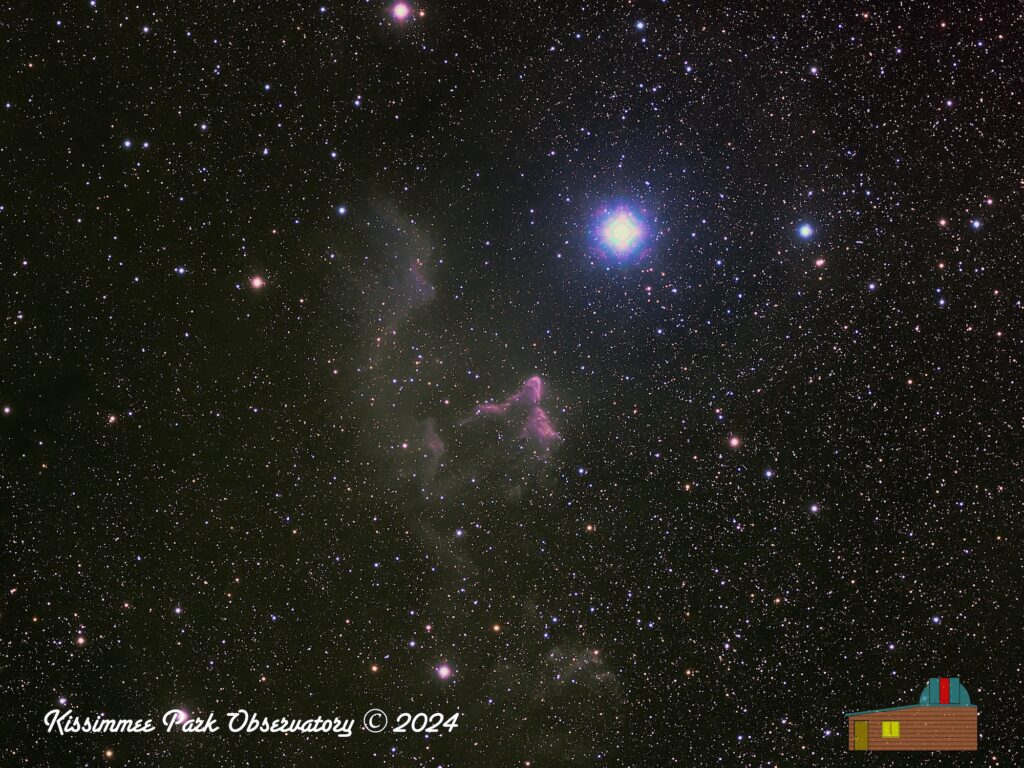
The Ghost of Cassiopeia, IC 59 & IC 63, as captured by the WFAC (Askar 400 Astrograph). This is an HaLRGB image, with total integration time of 5.75 hours. Click on the image to view a larger version you can explore.
The Eerie Beauty of the Ghost of Cassiopeia: IC 59 & IC 63
In the constellation of Cassiopeia, not far from the bright star Gamma Cassiopeiae, lies a pair of nebulous apparitions known together as the Ghost of Cassiopeia. These ghostly structures, officially designated as IC 59 and IC 63, offer a hauntingly beautiful sight for those who dare to peer into the night sky. We will delve into what makes these nebulas so unique, how to observe them, and the scientific intrigue they hold.
What Are IC 59 and IC 63?
- IC 59 and IC 63: These are reflection and emission nebulas, meaning they are illuminated by the light of the nearby star Gamma Cassiopeiae.
- IC 59 appears as a faint, ghostly glow, often resembling the shape of a spectral head with a cloudy mane.
- IC 63 is slightly brighter and more defined, often appearing as a ghostly figure or a flowing veil in the night sky.
- Location: Situated roughly 600 light-years from Earth, these nebulas are in close proximity to each other, creating an eerie duo in the Cassiopeia constellation.
Observing the Ghost of Cassiopeia
-
- Visibility: These nebulas are quite faint, making them challenging targets for visual observation:
- Telescopes: A moderate to large aperture telescope (8 inches or more) is recommended for visual observation.
- Filters: An OIII or UHC filter can help enhance the contrast between the nebula and the background sky.
- Astrophotography: For capturing the ghostly features of IC 59 and IC 63:
- Long Exposures: To capture these nebulas, long exposure times are needed, often requiring hours of integration to bring out their faint details.
- Equipment: A good astrophotography setup includes a camera with high sensitivity to low light, possibly with narrowband filters to isolate the glow from hydrogen and oxygen.
Scientific Importance
- Stellar Feedback: Gamma Cassiopeiae (Navi), a luminous blue variable star, plays a crucial role in shaping these nebulas. Its stellar wind and radiation sculpt the gas and dust, creating the complex structures we observe.
- Star-Formation Regions: While not as prominent as larger star-forming regions, these nebulas provide insight into how stellar winds and radiation affect the interstellar medium, potentially triggering or inhibiting star formation.
- Chemical Composition: Studying nebulas like IC 59 and IC 63 helps astronomers understand the distribution of elements in space, the processes of stellar evolution, and the life cycle of stars and nebulas.
The Ghostly Tale
- Mythological Connection: Named after Cassiopeia, the vain queen from Greek mythology who boasted about her unrivaled beauty, these nebulas can be seen as a celestial echo of her story, forever haunting the sky as a reminder of vanity or perhaps as a spectral beauty in her own right.
- Cultural Impact: While not as famed as some other nebulas, the Ghost of Cassiopeia has inspired artists and writers with its ethereal presence, serving as a muse for those intrigued by the mysteries of the cosmos.
Final Thoughts
IC 59 and IC 63, the Ghost of Cassiopeia, are not just visual spectacles but also windows into the dynamic processes governing the birth, life, and death of stars. For the stargazer, these nebulas offer a chance to witness the interplay of light and matter, where the energy from a star molds the very fabric of space around it. Whether through the lens of a telescope or the shutter of a camera, these ghostly forms remind us of the beauty and complexity of our universe, where even in death, there lies a haunting elegance.
Image Info
- Imaged from Chiefland Astronomy Village, Chiefland, FL (Bortle 4)
- Camera : ZWO ASI1600MM Pro
- Scope: Askar 400 Quintuplet Astrograph f/5.6
- Mount: iOptron Smart-EQ Pro
- Luminance: 11 subframes of 300s = 55 min integration
- Hydrogen Alpha (used as additional Luminance): 18 subframes of 300s = 90 min integration
- Red: 6 subframes of 300s = 30 min integration
- Green: 4 subframes of 300s = 20 min integration
- Blue: 6 subframes of 300s = 30 min integration
- Total integration time: 225 min = 3.8 hours.
- Captured via ASIAir Pro automation
- Optical tracking via ASIAir automation via the ASI120MM-S guide camera
- Separate channels stacked and HaLRGB integrated in Astro Pixel Processor
- Image run through Super DeNoising
- Final processing in Aperture
